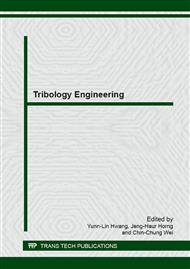p.152
p.162
p.168
p.174
p.179
p.184
p.190
p.196
p.202
Tribological Characteristics of Amorphous Hydrogenated DLC in the Presence of Commercial Lubricating Oil
Abstract:
Currently diamond like carbon (DLC) coatings application for automotive components is becoming a favorable strategy to cope with new challenges faced by automotive industries. DLC coating is very effective to lower the coefficient of friction and wear rate, which in turn could improve fuel efficiency and durability of the engine components. Commercially available fully formulated lubricating oils are specially produced to enhance the lubrication of ferrous materials. Therefore, nonferrous coating (DLC) interaction with commercial lubricating oil needs to be investigated. In this current investigation, coefficient of friction and wear rate were investigated by ball on plate tribo testing machine at different temperatures in the presence of SAE 40 lubricating oil. At high test temperature coefficient of friction decreases, however wear rate increases for the a-C:H coated plate, however, steel/steel contact shows opposite trend of coefficient of friction and wear rate change.
Info:
Periodical:
Pages:
179-183
Citation:
Online since:
April 2015
Authors:
Keywords:
Price:
Сopyright:
© 2015 Trans Tech Publications Ltd. All Rights Reserved
Share:
Citation:


